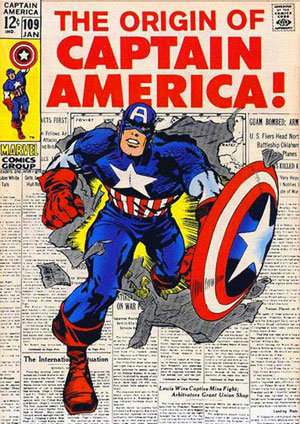

| Online: | |
| Visits: | |
| Stories: |

| Story Views | |
| Now: | |
| Last Hour: | |
| Last 24 Hours: | |
| Total: | |
Superhero Physiology: Could We Make a Captain America?
Saturday, March 11, 2017 12:17
% of readers think this story is Fact. Add your two cents.
A common challenge to educators across all disciplines is making learning interesting for students.
Researchers from Mississippi State University outline a compelling strategy to teach physiology to undergraduate students: using real physiological concepts to explain some of the extreme physical transformations of the fictional superhero Captain America. The article is published in Advances in Physiology Education.
Captain America was once a young man named Steve Rogers with a below-average body type and normal abilities. After receiving a mysterious injection, Rogers underwent “extensive physical and physiological changes, all of which are unachievable even with years of intense exercise training.”
Cover of Captain America 109 (January 1969).by Jack Kirby (pencils) & Syd Shores (inks).
Credit: Wikipedia
The research team provides examples of real changes that actually can occur in the body to explain how Captain America could have turned into a superhero of extreme endurance and power, including:
• Deactivated muscle-specific nuclear receptor corepressor 1 (NCoR1) protein. Mouse studies show that a lack of NCoR1 leads to increased muscle mass and endurance.
• Altered gene expression regulating muscle growth, making the muscles larger.
• Extreme metabolic efficiency. Captain America is rarely shown eating and does not seem to tire out, which means he does not need much fuel for his body to function at high levels.
• A combination of fast-twitch and slow-twitch muscle fibers, allowing Captain America to have superhuman muscle strength, endurance and power.
The goal in discussing actual physiological characteristics alongside the fantastical feats of a fictional character is “to use the pop icon as a fun way to encourage critical thinking and spark in-class discussions,” wrote the researchers.
“The numbers and concepts of science being taught may potentially have a far greater impact when pop icons such as Captain America are used in the classroom. Suddenly, the concepts are not so dry, and the numbers can be rather compelling and entertaining.”
Contacts and sources:
American Physiological Society (APS)
Citation“Superhero physiology: the case for Captain America,” published in Advances in Physiology Education.
Source: http://www.ineffableisland.com/2017/03/superhero-physiology-could-we-make.html



